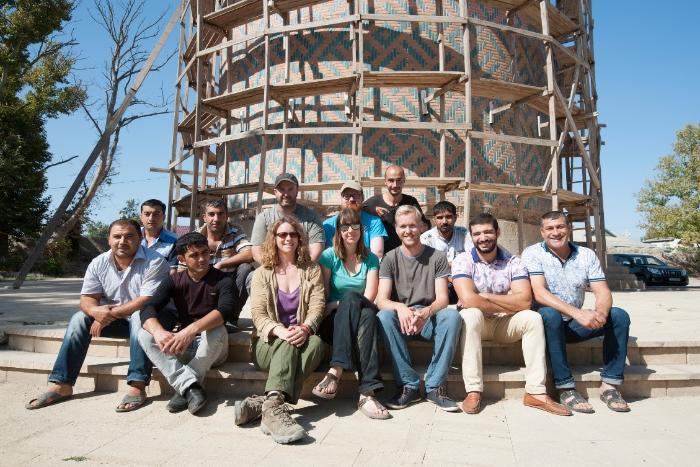The Landscape of Medieval Barda, Azerbaijan 6th - 13th Centuries AD
PhD Candidate: David Stone
Supervisor: (opens in a new window)Assoc. Professor Meriel McClatchie
Funded By: (opens in a new window)Irish Research Council Government of Ireland Postgraduate Scholar (2017-2020); UCD College of Social Science and Law Scholarship (2016-2017)
Abstract
‘The Landscape of Medieval Barda, Azerbaijan 6th - 13th Centuries AD’ project is a pioneering environmental archaeological research initiative aiming to explore and chart the history of the medieval Caucasian regional capital of Barda, Azerbaijan though the study of archaeobotanical material. This project will explore these issues by drawing on recently generated archaeobotanical data collected from a new fieldwork project, The Archaeological Exploration of Barda (AEB), based in the Faculty of Oriental Studies at the University of Oxford. The AEB aims to chart the development of the late Antique and medieval city of Barda with excavations centred around two main sites, the first, Torpak Kala, located in the heart of the city of Barda and the second a rural tepe mound located at Quaratepe, outside the city.

2015 AEB Excavation Team
Archaeobotanical material excavated at these two sites during the previous two field seasons (2015 and 2016) have been collected and processed and are awaiting analysis. Central to this project is the identification of evidence of continuity or adjustment in agricultural practices and local land management throughout the period being studied. The use of novella environmental techniques in medieval Azerbaijani archaeology will reveal new insights into the use of plants during the development of this important urban centre, and demonstrate the impacts of political and administrative changes on urban and rural plant management and food procurement in the region between the 6th –13th centuries AD. The project also aims to connect the history of the city with the development of the surrounding landscape, understanding the administration of this region as a ‘province’. Furthermore, as well as answering the research questions above, archaeobotanical survey and analysis of plant micro and macro fossils will play a key role in the wider study of the medieval populations of both rural and urban settlements in Western Azerbaijan.
Methodologically, the research project can be divided into three stages including fieldwork and sampling and processing, comparison and analysis. The first stage of the research is to design, implement and test an appropriate, integrated soil sampling strategy for future excavation seasons in the AEB project, in order to collect high quality archaeobotanical remains of phytoliths, charcoal, pollen and carbonised seeds and chaff for archaeobotanical analysis. Analysis will focus primarily on seeds and chaff with more basic analysis of other remains in advance of more detailed analysis in the future. The completion of two excavation seasons have produced over 20kg of archaeobotanical flots with two further seasons of excavation planned during 2017 and 2018 expected to increase material for analysis substantially. This will create a comprehensive dataset of high quality samples from across the excavations in the city and at regional survey sites. Soil samples collected from deposits will be supplemented with samples of building materials including mud brick from structures and tandoor ovens which can give further insights into the plants utilised. Preservation is the most prominent constraint for archaeobotanical analysis in this research project. Climate and soil conditions prevalent in the B?rd? region are most conducive to the survival of charred remains. The research will therefore focus on charred or carbonised material such as grains/seeds, chaff and charcoal. Analysis of the charcoal of carbonised wood and basket material will provide information on woodland species makeup and ecology reconstruction.
The second stage involves laboratory identification, quantification and interpretation of material. As a principal step, this will enable the compilation of the first ever taxonomic list of plant species utilised in the Barda region. Through the identification of changes of concentrations of different plant groups and the identification of new species introduced it will be possible to reconstruct changes in land use and agricultural strategies over time. Meanwhile the analysis of domestic soil samples will provide information on aspects of diet, including wild and cultivated foods by the inhabitants of the city and countryside. Finally, through studying botanical remains in different kinds of archaeological deposit it will be possible to think critically about the formation processes of the excavated sites.
During stage three, data will be collated and analysed as the basis for identifying agricultural, processing and management practices and techniques and how these may have changed or continued. Central to this study is the isolation of associated weed species, for the application of phytosociological, autecological and functional approaches to recreate specific growing conditions, husbandry practices and ecological factors. At a broader level, statistical classification of different crop plant components and weed seeds can reveal unique sequences of crop processing stages. The application of crop processing models to botanical assemblages has been traditionally used to interpret both landscape management and the organisation of labour in crop-processing. Likewise, inter-site comparisons can identify discrete areas of production and processing by assessing the proportions of grains/seeds to chaff material using, for example Correspondence Analysis to determine the statistical significance of the differences observed.